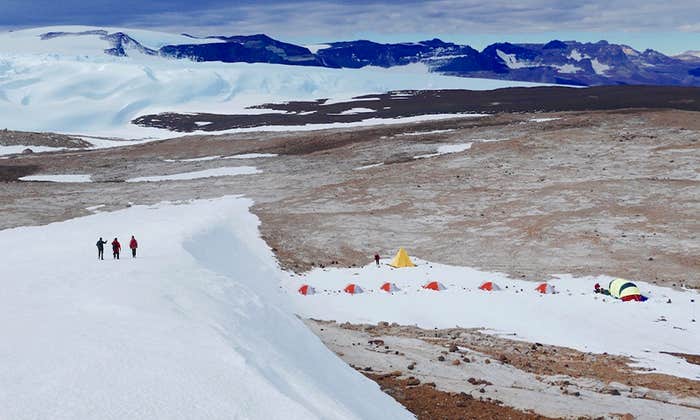I first met James Lovelock in 1988 at a conference on his controversial Gaia Hypothesis that was sponsored by the American Geophysical Union. Gaia, to remind you, was the mythical Greek goddess who embodied Mother Earth. The Gaia Hypothesis is the idea that life, or Gaia, plays a critical role in maintaining Earth’s habitability, including its oxygen-rich atmosphere, the salinity of its oceans, and its relatively stable climate. In the late 1960s, Lovelock had postulated that particular control mechanisms require feedback loops to ensure stability. Indeed, Lovelock initially called his theory the “Earth feedback hypothesis,” but changed it to the more mythical title following a suggestion from the novelist William Golding, who happened to live in the same English town.
I was a young scientist then, and I had a different idea about Earth’s feedback mechanisms. Jim, like most good scientists, accepted my criticism without rancor, but we were clearly on different sides of the issue. The Gaia Hypothesis was having a powerful impact on the environmental movement by encouraging people to think of the Earth holistically, as a kind of super-organism that protects us and deserves our protection. I had to agree, though, with the scientists Ford Doolittle, Richard Dawkins, and Stephen Jay Gould, that a planet or planetary ecosystem cannot evolve like an individual organism, and is unlikely to have developed in such a way as to stabilize the Earth system. As Jim’s famous hypothesis approaches its 50th anniversary, it has lasting value. But to understand Earth’s long-term climate stability, we need to look past Gaia.
Now, I said Earth’s climate is “relatively” stable. It’s important to begin with that qualifier because many geoscientists, including me, believe the oceans may have frozen completely over at least three times during Earth’s history. These so-called “Snowball Earth” events are thought to have occurred during the Late Proterozoic, around 600-800 million years ago, and also in the early Proterozoic, around 2.3 billion years ago. Life made it through these events, however, and there is good evidence that life has been continuously present on Earth’s surface since at least 3.5 billion years ago. Earth itself is more than 4.5 billion years old, having formed shortly after the formation of the sun.
Why should it be considered surprising that Earth has been inhabited for this long? What intrigued Lovelock, along with astronomer Carl Sagan, who co-wrote a paper about it back in 1972, was that the sun is thought to have increased significantly in luminosity over this time interval. To be precise, the sun was about 30 percent dimmer 4.5 billion years ago, and it has brightened more or less linearly since then. All other things being equal, this implies that Earth’s surface should have been completely frozen prior to about 2 billion years ago. But it wasn’t—the Snowball Earth glaciations were brief, and the two best-documented episodes occurred somewhat later. Although the geologic record of the early Earth is rather spotty, climate during the first half of Earth’s history appears to have been, if anything, even warmer than today.
Lovelock accepted my criticism without rancor, but we were clearly on different sides of the issue.
Keeping Earth habitable over long time periods requires that various feedback mechanisms must have been in operation. Specifically, one needs negative feedback to counter the climatic cooling induced by the faint young sun. Earth’s climate system includes numerous feedback processes, some negative and some positive. Two of the easiest climate feedbacks to understand are those involving water vapor and ice albedo. (The term “albedo” simply means reflectivity.) Water vapor is a greenhouse gas that helps to warm Earth’s surface. Its concentration in the atmosphere increases with surface temperature; hence, warmer surface temperatures lead to more water vapor, which in turn leads to warmer temperatures—a positive feedback loop. Conversely, colder surface temperatures should lead to less water vapor, and to even colder temperatures. So the water vapor feedback makes the faint young sun problem worse, not better. The same is true of ice albedo feedback: colder temperatures create more snow and ice, which reflect away more of the sun’s rays, and this leads to still colder temperatures.
Earth’s climate system must contain negative feedback loops, as well. If it didn’t, the system would be perpetually unstable. The most fundamental negative feedback loop is the link between surface temperature and the outgoing infrared radiation. As Earth’s surface heats up, it emits more infrared radiation. But emission of infrared energy cools the surface, and so this is a negative feedback. This feedback is so basic that it is often overlooked. But this is what keeps our climate stable on a day-to-day or year-to-year basis.
The infrared radiation-surface temperature feedback loop is not enough to stabilize Earth’s climate over long time scales, though, because the system is forced by long-term changes in solar luminosity, or brightness, amplified by the positive feedback loops. We need a negative feedback loop that stabilizes climate over long time scales.
Lovelock realized this back in the 1960s, and this spawned his Gaia Hypothesis. He knew that CO2, along with H2O, is a major greenhouse gas in Earth’s present-day atmosphere. He was also aware that atmospheric CO2 levels can vary with time as a consequence of imbalances in the global carbon cycle.
Lovelock focused on the organic carbon cycle, in which plants and algae use CO2 and H2O to create organic matter (CH2O) and oxygen (O2) by way of photosynthesis. This process is reversed through the process of respiration, which is carried out by both animals and plants, and by aerobic decay, which is carried out by bacteria. With this cycle in mind, Lovelock hypothesized that atmospheric CO2 levels were much higher on the early Earth, and this created additional greenhouse effect that helped to offset the faint young sun. Then, as the sun gradually brightened over time, plants and algae drew CO2 out of the atmosphere at just the right rate to counter the brightening sun. This, then, was Gaia. Earth’s biota regulated the atmospheric CO2 content over time, stabilizing the climate and ensuring their own continued existence.
As its influence spread, Lovelock’s hypothesis came under criticism. How would the biota know how fast to draw down CO2? Wouldn’t this require intelligent insight into the problem? And, most tellingly, how could the process of natural selection operate on an ensemble of different organisms?
Some biologists characterized the Gaia Hypothesis as being teleological, or assigning human characteristics to inanimate objects. Lovelock attempted to counter the criticism with a parable about a fictitious planet he named “Daisyworld,” which maintained a stable surface temperature just because of the nature of the daisy growth curve, which optimizes at a certain temperature. (Lovelock owns an estate in the English countryside and has long been proud of his ability to cultivate daisies and other native plants on his farm.) He was at least partly correct: One can certainly stabilize a planet’s climate if it depends entirely on the albedo feedback provided by black or white daisies. Indeed, we use Daisyworld as a teaching tool in an introductory Earth science class that I teach at Penn State. This does not, however, necessarily imply that the biota stabilize Earth’s climate, which rests more strongly on the concentrations of various greenhouse gases than it does on surface albedo.
In fact, the carbon cycle, which controls atmospheric CO2 concentrations over time, has several parts. Lovelock emphasized the organic carbon cycle but ignored the inorganic carbon cycle, or carbonate-silicate cycle. Most geoscientists believe that the inorganic carbon cycle is more important in controlling atmospheric CO2 over long time scales because the organic carbon cycle controls, and is partly controlled by, atmospheric oxygen.
As its influence spread, the hypothesis came under criticism. How would the biota know how fast to draw down carbon dioxide?
Here’s how the inorganic carbon cycle works. It starts when atmospheric CO2 dissolves in rainwater, creating carbonic acid, H2CO3. Carbonic acid is a weak acid—so weak that we consume it in carbonated beverages—but it is strong enough to dissolve silicate rocks on the continents in a process termed weathering. The byproducts of silicate weathering collect in streams and rivers and are carried down to the ocean, where they are used by certain algae to make calcium carbonate shells, a process termed carbonate precipitation. When the organisms die, they fall into the deep ocean. Most of the shells redissolve, but some of them get buried in sediments on the seafloor. The seafloor is continually moving because of plate tectonics, and at certain plate boundaries, the seafloor is subducted (carried down into the mantle), the carbonate sediments are heated up, and gaseous CO2 is released in a process termed carbonate metamorphism. This CO2 is then vented back into the atmosphere by volcanoes, like Mt. St. Helens or Mt. Pinatubo.
Like the climate control mechanism in the Gaia Hypothesis, the carbonate-silicate cycle contains a negative feedback loop. The process of silicate weathering is temperature-dependent: Warmer temperatures lead to more rapid weathering, and hence to faster removal of CO2 from the atmosphere. This process is slow, so in the short term it won’t help us to deal with global warming, because humans are increasing atmospheric CO2 faster than silicate weathering can remove it. But it can help enormously with climate stabilization on geologic time scales.
If surface temperatures in the distant past were low as a consequence of reduced solar luminosity, weathering should have been slower, and volcanic CO2 should have accumulated in the atmosphere. Evidence that this process occurs is provided by the so-called cap carbonates that lie atop the glacial deposits in Late Proterozoic. These are thought to represent the CO2 that built up in the atmosphere during the Snowball Earth episodes. High atmospheric CO2 concentrations would have been further encouraged early in Earth’s history because the young Earth was hotter inside and should therefore have been more volcanically active. So there is every reason to believe that CO2 levels could have risen high enough to offset the faint young sun and keep the early Earth from freezing, all without explicit help from the biota.
Ah, but I appear to have contradicted myself, haven’t I? Most carbonate precipitation today is performed by the biota, specifically, by calcareous algae that make their shells out of calcium carbonate. So, life is involved in the inorganic carbon cycle, as well as the organic carbon cycle. It turns out that this particular form of involvement doesn’t matter too much. Calcareous algae only evolved about 200 million years ago, and so before this time carbonate precipitation occurred by other mechanisms. The details are unimportant because the factor that controls the removal rate of CO2 from the atmosphere is the weathering process itself. But the biota also play a role in this part of the cycle: Land plants pump up the CO2 concentration in soils by root respiration, and release humic acids that further accelerate weathering, drawing down atmospheric CO2. We argue about how big this effect is, but the climate would almost certainly be warmer today if life was not present. So, the Gaia theory is at least partly correct. But this does not necessarily imply that Earth would be uninhabitable if life were not present. It merely says that an uninhabited Earth would be different, maybe a little warmer, but still habitable.
While Lovelock still believes in Gaia, he does not think she will save us from our follies.
This story has one more wrinkle, which I will mention briefly.1 Methane, CH4, may have been more abundant in the distant past prior to the rise of atmospheric O2 around 2.4 billion years ago. Methane is a greenhouse gas, and it could have provided an additional 10-12 degrees (Celsius) of warming. You need about 30 degrees of warming to solve the faint young sun problem, so methane could have provided about one-third of the solution. Methane is also produced almost exclusively by the biota—specifically, by methanogenic bacteria, or methanogens, for short. There are feedback loops in this system, as well: Too much methane causes it to polymerize (form long chains) and create organic haze, like the haze that we see on Saturn’s moon, Titan—this cools the surface by creating an anti-greenhouse effect. That would kill off many of the methanogens, slowing methane production and reducing the amount of organic haze. So, this part of the climate control cycle is quite Gaian, even though it has not been emphasized by Lovelock or his followers.
In fact, it may well be that Gaia was more active prior to the rise of O2 than she has been in more recent times. The reason is that methane was an extremely important greenhouse gas during the first half of the Earth’s history, whereas climate during the second half has been controlled mostly by CO2 and H2O. I should note that methane is still an important greenhouse gas, accounting for 1-2 degrees (Celsius) of warming today, and that its concentration has also been increasing along with CO2 as a consequence of human activities, especially natural gas leakage and agriculture. So, if humans are considered part of Gaia, then Gaia is presently destabilizing Earth’s climate. Lovelock comes to that same conclusion in his later books.
Several years after the conference where I met Lovelock, I attended another conference on the Gaia Hypothesis. This one was organized by Jim himself, and it was held at the University of Oxford in England. It was a three-day conference, and I gave my talk on the first day. I talked mostly about the carbonate-silicate cycle, giving the argument I have outlined above, that Gaia was unnecessary to explain Earth’s climate stability. But that was the last thing I said at the conference. The night following my talk, I was stricken with laryngitis, and I literally could not say a word for the next two days. I remember feeling frustrated at the time, but as the years have gone by, I’ve come to think that my inability to speak may have been a blessing in disguise.
For, in spite of our scientific differences, I’ve always admired Jim Lovelock. He was, and still is, a truly fresh thinker, and he presents his ideas eloquently, both in his talks and books. I have particularly liked his comparison of Earth to a giant redwood tree2: 99 percent of a redwood is dead, and only the thin, outside layer—the bark—is alive, and yet the tree itself is most certainly alive. Similarly, Earth is mostly inanimate rock, yet its thin layer at the surface—the biosphere—is alive, or at least filled with life. Might we not also think of the planet itself as being alive? It’s a thoughtful analogy and a good example of why the Gaia Hypothesis has attracted devoted followers, and why Jim has been a source of inspiration to environmentalism worldwide. While he still believes in Gaia, he does not think she will save us from our follies. If Gaia pushes us toward a better understanding of how we are tampering with Earth’s present climate, it will remain a very important hypothesis indeed.
James F. Kasting is a planetary scientist/geoscientist at Penn State University. His work focuses on the long-term evolution of Earth’s atmosphere and climate, and on the possibility of finding life on planets around other stars.
References
1. For more detail, see my book, How to Find a Habitable Planet Princeton University Press (2009).
2. Lovelock, J. Ages of Gaia Norton (1988).


























